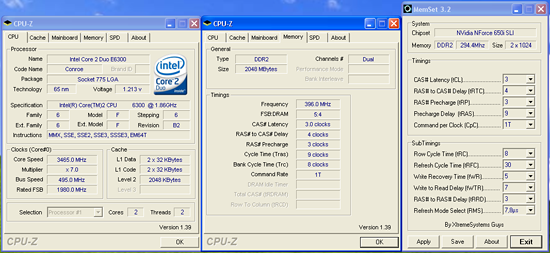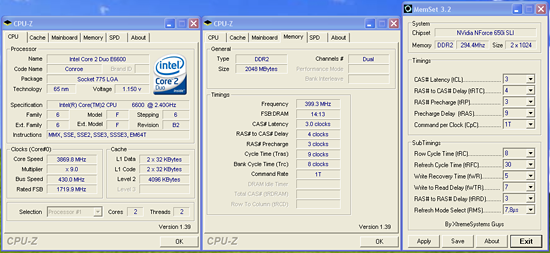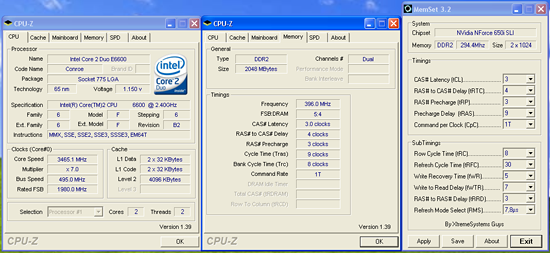ASUS P5N32-E SLI Plus: NVIDIA's 650i goes Dual x16
by Gary Key on April 2, 2007 3:30 AM EST- Posted in
- Motherboards
Overclocking - E6300
We were able to reach a final benchmark stable setting of 7x495 FSB resulting in a clock speed of 3465MHz. We were able to run our OCZ Flex PC2-9200, OCZ Flex PC2-6400, and our Corsair PC2-8888 at the reported timings with a 1T Command Rate enabled with 2.250V. When overclocking we were able to run our standard OCZ Flex PC2-6400 at 1T command rates with very aggressive sub-timings. Vdroop was very good on this board during E6300 overclocking with an average drop of .02V during load testing with our E6300.
Testing with our new OCZ Flex PC2-6400 CAS3 (standard memory installed) and G.Skill F2-6400CL4D-2GBHK modules based on ProMOS IC chips resulted in great success on this board. The OCZ Flex PC2-6400 was able to run up to DDR2-850 speeds with timings at 3-4-3-9 1T at 2.250V and the G.Skill F2-6400CL4D at 4-3-3-9 1T at 2.20V. The remaining memory timings are set to Auto as is standard in our testing and manually adjusting these timings resulted in increased stability while overclocking while minimally decreasing performance in certain games and applications that are memory sensitive. We did notice in 4GB testing that we had to change our OCZ Flex PC2-6400 CAS3 memory timings to 3-4-4-10 2T at 2.275V for stable 24/7 operation in a variety of applications.
Overclocking - E6600
After trying numerous voltages and memory timings we discovered our 9x430 FSB setting was the limit for both our board and CPU. This resulted in a final clock speed of 3869MHz at 1.4750V which is the limit for our Tuniq 120 air cooler. We did find the typical FSB hole around 416FSB but did not notice the same issues we had with the 680i LT SLI having several FSB ranges that were unusable. We were able to post and complete benchmark testing at 435FSB but could not pass dual Prime95 at that setting. Vdroop was very acceptable but not great during overclocking with an average drop of .03V ~ .04V during load testing with our E6600. We generally found that without decent airflow around the CPU and memory locations that our maximum FSB was near 408 with this configuration.
We dropped the multiplier on our E6600 to seven and were able to reach the same 495 FSB level as with the E6300. We were able to enter XP at 7x515 but the board was not stable, and we could complete all benchmarks at 7x510 except for dual Prime95. At first we thought the board was locked at 500FSB but once again we found FSB holes but this time they ranged from 502 to 516. We noticed in overclock testing that we were able to extract an 1133 memory speed at 5-5-4-15 2T timings at 2.20V with our OCZ Flex PC2-6400. This matches the 680i LT SLI speeds at slightly better timings although performance differences were minimal with sub-timings set the same. We dropped in our OCZ Flex PC2-9200 and Corsair PC2-9136 modules with both being able to reach DDR2-1275 but at 5-5-5-18 timings compared to the 5-5-4-12 2T timings at 2.30V on the 680i LT SLI board. Memory performance and stability was superb once the board was dialed in.
| ASUS P5N32-E SLI Plus Dual Core Overclocking |
|
| Processor: | Intel Core 2 Duo E6300 Dual Core, 1.86GHz, 2MB Unified Cache 1066FSB, 7x Multiplier |
| CPU Voltage: | 1.4500V (default 1.3250V) |
| NB Voltage: | 1.45V |
| 1.2V HTT Voltage: | 1.40V |
| SB Voltage: | 1.50V |
| CPU VTT: | 1.25V |
| Cooling: | Tuniq 120 Air Cooling |
| Power Supply: | OCZ ProXStream 1000W |
| Memory: | OCZ Flex XLC PC2-6400 (2x1GB) |
| Video Cards: | 1 x MSI 8800GTX |
| Hard Drive: | Western Digital 150GB 10, 000RPM SATA 16MB Buffer |
| Case: | Cooler Master CM Stacker 830 |
| Maximum OC: | 495x7 (3-4-3-9 1T, 792MHz, 2.250V), CPU 1.4500V 3465MHz (+86% FSB/CPU) |
| . | |
 |
| Click to enlarge |
We were able to reach a final benchmark stable setting of 7x495 FSB resulting in a clock speed of 3465MHz. We were able to run our OCZ Flex PC2-9200, OCZ Flex PC2-6400, and our Corsair PC2-8888 at the reported timings with a 1T Command Rate enabled with 2.250V. When overclocking we were able to run our standard OCZ Flex PC2-6400 at 1T command rates with very aggressive sub-timings. Vdroop was very good on this board during E6300 overclocking with an average drop of .02V during load testing with our E6300.
Testing with our new OCZ Flex PC2-6400 CAS3 (standard memory installed) and G.Skill F2-6400CL4D-2GBHK modules based on ProMOS IC chips resulted in great success on this board. The OCZ Flex PC2-6400 was able to run up to DDR2-850 speeds with timings at 3-4-3-9 1T at 2.250V and the G.Skill F2-6400CL4D at 4-3-3-9 1T at 2.20V. The remaining memory timings are set to Auto as is standard in our testing and manually adjusting these timings resulted in increased stability while overclocking while minimally decreasing performance in certain games and applications that are memory sensitive. We did notice in 4GB testing that we had to change our OCZ Flex PC2-6400 CAS3 memory timings to 3-4-4-10 2T at 2.275V for stable 24/7 operation in a variety of applications.
Overclocking - E6600
| ASUS P5N32-E SLI Plus Dual Core Overclocking |
|
| Processor: | Intel Core 2 Duo E6600 Dual Core, 2.4GHz, 4MB Unified Cache 1066FSB, 9x Multiplier |
| CPU Voltage: | 1.4750V / 1.4500 (default 1.3250V) |
| NB Voltage: | 1.45V |
| 1.2V HTT Voltage: | 1.45V |
| SB Voltage: | 1.50V |
| CPU VTT: | 1.35V / 1.30V |
| Cooling: | Tuniq 120 Air Cooling |
| Power Supply: | OCZ ProXStream 1000W |
| Memory: | OCZ Flex XLC PC2-6400 (2x1GB) |
| Video Cards: | 1 x MSI 8800GTX |
| Hard Drive: | Western Digital 150GB 10, 000RPM SATA 16MB Buffer |
| Case: | Cooler Master CM Stacker 830 |
| Maximum CPU OC: | 430x9 (3-4-3-9 1T, 799MHz, 2.25V), CPU 1.4750V 3869MHz (+61%) |
| Maximum FSB OC: | 495x7 (3-4-3-9 1T, 792MHz, 2.25V), CPU 1.4500V 3465MHz (+86% FSB) |
| . | |
 |
| Click to enlarge |
After trying numerous voltages and memory timings we discovered our 9x430 FSB setting was the limit for both our board and CPU. This resulted in a final clock speed of 3869MHz at 1.4750V which is the limit for our Tuniq 120 air cooler. We did find the typical FSB hole around 416FSB but did not notice the same issues we had with the 680i LT SLI having several FSB ranges that were unusable. We were able to post and complete benchmark testing at 435FSB but could not pass dual Prime95 at that setting. Vdroop was very acceptable but not great during overclocking with an average drop of .03V ~ .04V during load testing with our E6600. We generally found that without decent airflow around the CPU and memory locations that our maximum FSB was near 408 with this configuration.
 |
| Click to enlarge |
We dropped the multiplier on our E6600 to seven and were able to reach the same 495 FSB level as with the E6300. We were able to enter XP at 7x515 but the board was not stable, and we could complete all benchmarks at 7x510 except for dual Prime95. At first we thought the board was locked at 500FSB but once again we found FSB holes but this time they ranged from 502 to 516. We noticed in overclock testing that we were able to extract an 1133 memory speed at 5-5-4-15 2T timings at 2.20V with our OCZ Flex PC2-6400. This matches the 680i LT SLI speeds at slightly better timings although performance differences were minimal with sub-timings set the same. We dropped in our OCZ Flex PC2-9200 and Corsair PC2-9136 modules with both being able to reach DDR2-1275 but at 5-5-5-18 timings compared to the 5-5-4-12 2T timings at 2.30V on the 680i LT SLI board. Memory performance and stability was superb once the board was dialed in.










37 Comments
View All Comments
JarredWalton - Monday, April 2, 2007 - link
Sorry - just an errant typo correction. If you look at the image, you can see it's 1T. Gary had "TT" in there and I corrected that to 2T when it should have been 1T.yacoub - Monday, April 2, 2007 - link
oh awesome :)mostlyprudent - Monday, April 2, 2007 - link
I think it's time for a comprehensive article to pick the best boards for Intel CPUs (P965 vs. 680i vs. 650i vs. 680i LT vs. 975X vs. RD600, etc.). I know some of this has been done in pieces, but it would sure be nice to have it all in one article. Please :)Gary Key - Monday, April 2, 2007 - link
After I finally complete the opus known as uATX or "How to kill the reviewer", we will have a performance roundup that might even include a new spin of the P35. ;-)yacoub - Monday, April 2, 2007 - link
It'd be awesome to see a round-up in time for the April 22nd Intel price drop and 6320/6420 release.I want to know simply: "The Best 650 SLI and 680 SLI NVidia-based Boards For 6320/6420 OverClocking" and NOT with any of that ridiculously over-priced Dominator or Flex XLC RAM. Just test with realistic RAM that actual people would buy like Corsair XMS2 or OCZ Platinum series and similar. High-end RAM but not retarded over-priced stuff with gigantic cooling mechanisms. Test RAM that's around $250 (or less) for 2GB matched pairs.
That's what I'd like to see. An actual overclocker 650/680 board round-up for the 6320/6420 c2d chips with RAM people who are looking for the best bang-for-the-buck would actually buy.
People who spend around $200-250 for the motherboard, $200-250 for quality, low-latency RAM, and $200 for the CPU.
There's a lot of us and we'd love to know which board to buy and which RAM works best with it when oc'ing.
sWORDs - Tuesday, April 3, 2007 - link
The OCZ2N1066SR2GK only costs €208 here, that's SLI ready, 1066 MHz, 5-5-5-15, 2x 1GB.The OCZ2N900SR2GK only costs €192 here, that's SLI ready, 900 MHz, 4-4-3-15, 2x 1GB.
yacoub - Monday, April 2, 2007 - link
This image link on page4 is different than the actual image:http://images.anandtech.com/reviews/motherboards/a...">http://images.anandtech.com/reviews/mot...sus/p5n3...
http://images.anandtech.com/reviews/motherboards/a...">http://images.anandtech.com/reviews/mot...sus/p5n3...
(I think one of the sample images is duplicated.)
JarredWalton - Monday, April 2, 2007 - link
Did someone fix this? They are definitely different images for me, although only minor differences.Marlowe - Monday, April 2, 2007 - link
Very nice review - looks like a good board! After reading the article I have some questions:Isn't the 'Plus' moniker ment to mean some kind of functionality with Vista? I think I remember when some previous Asus board got a new revision and the got the Plus moniker, it also got a small PCB riser board attached below the IO area.. ReadyBoost or something? Does this board have that? It's not that copper square behind the LAN/USB connections? Or maby it's just a new name for their mid-range boards.
Isn't that a 6-phase power circuit in the pics? I know the Asus site claims 8-phase, but they also have a wrong power circuit pic. The site also says "With the highest speed up to 800MHz," about the memory speed and doesn't mention support for EPP at all, so that must be wrong as well according to your article?
In the expansion slot area you write "two PCI Express x1" but that's not so? Isn't the top slot for the "SupremeFX" audio riser board?
In the Dual Core OC page, the E6300 has 2MB L2 not 4MB :)
And a question: I have the Tuniq120 as well, and the fan is placed ~7 cm over the board and placed in an angle so I guess there aren't much airflow going to those heatpipe sinks. Did you have to use an additional fan over the cpu area while using the Tuniq120 heatsink and overclocking? So if overclocking you *have* to hang some fan with zip ties or something over that area? Thats a bit of a hassle isn't it :P
Anyways very nice performing board :D Looks physically totally identical to the Asus P5N32-E SLI tho :D But
sWORDs - Tuesday, April 3, 2007 - link
The E Plus is ment as an upgrade to the E, it has all solid caps just as the Striker.The E, E Plus and Striker all use the same PCB (just look under the white sticker) and all have a 8 phase power design.
All three have EPP and SLI Ready support up the 1200 (and the 1250 works as well).
The top one can only be used for the riser.
True.
The Northbridge does get very hot, however using the heatpipes should be enough to reach 450. Any busspeed above 400 isn't recommended anyway because of the reduction of timing from the strap selection.
True, they share the same PCB, this one has the same caps as the Striker.